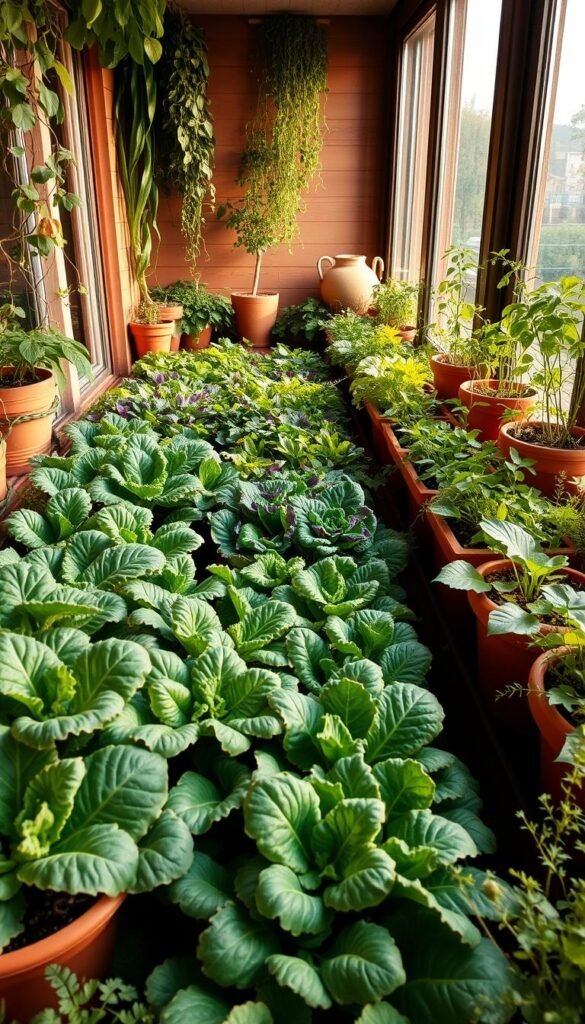Imagine stepping onto your balcony and picking crisp lettuce, fragrant herbs, or juicy cherry tomatoes whenever you want. With succession planting, you can turn even the smallest outdoor space into a vibrant, ever-producing garden. This method isn’t just for sprawling backyards—it’s perfect for urban dwellers craving fresh flavors year-round.
By staggering your seeds and plants throughout the season, you’ll enjoy a nonstop harvest. Start with cool-weather greens in spring, swap in heat-loving veggies for summer, and transition back to hardy crops as temperatures drop. No need to wait weeks between harvests—your containers or vertical setups keep the bounty coming.
Think your balcony’s too tiny? Think again! Compact pots, hanging planters, and tiered shelves let you grow more in less space. Pair quick-growing radishes with slower-maturing peppers, or mix leafy greens that thrive in partial shade. The key is timing: sowing new batches every few weeks ensures something’s always ready to pick.
Ready to ditch grocery-store herbs and taste the difference? In the next sections, you’ll learn how to plan your planting schedule, choose the right seeds, and troubleshoot common challenges. Let’s turn that sunny corner into your personal produce aisle!
The Basics of Succession Planting
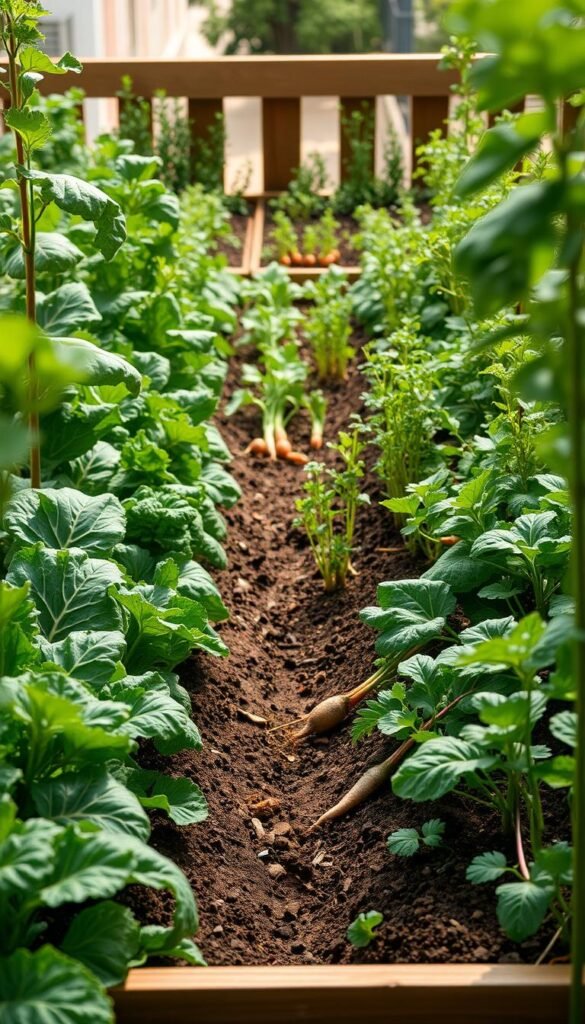
Ever wish your small garden could produce veggies all year? That’s where succession planting shines. Instead of growing one crop and waiting weeks for the next batch, you’ll plant in stages. This keeps your containers full and your meals flavorful.
What Is Succession Planting?
It’s a smart way to maximize yields by timing your seed sowing. For example, plant lettuce every 10-14 days. When one batch is picked, the next is halfway grown. Pair quick varieties like radishes with slower ones like tomatoes. No empty pots!
Benefits for Continuous Harvests
Why try this method? First, you’ll outsmart pests. Bugs love feasting on one big crop. Staggered plants confuse them. Second, you’ll use space better. Swap spring peas for summer basil, then fall kale. Space-saving veggies keep your harvests rolling.
| Traditional Planting | Succession Method |
|---|---|
| Single harvest per season | 3-4 harvests from the same space |
| Long gaps between crops | New growth starts before old ends |
| Higher pest risk | Disrupts insect life cycles |
Timing matters. Check each plant’s maturity days. Basil takes 60 days? Sow seeds every 3 weeks for nonstop pesto. Mix leafy greens that thrive in shade with sun-loving herbs. Even beginners can master this rhythm!
Planning Your Balcony Garden for a Continuous Harvest

Transform your outdoor nook into a productive oasis by mapping out three key elements: sunlight patterns, container sizes, and seasonal shifts. Start by sketching your balcony layout—note where shadows fall at different times of day. This reveals prime spots for sun-loving tomatoes versus shade-tolerant spinach.
Smart Space Evaluation
Measure your available space before choosing containers. Follow this checklist:
- Track daily sunlight hours using a free app
- Group plants by water needs to simplify care
- Use vertical stackers for herbs and trailing vines
Deep pots work best for carrots and dwarf fruit trees, while shallow window boxes suit lettuces. Leave 6-8″ between containers for air circulation—overcrowding invites disease.
Seasonal Planting Rhythms
Sync your gardening calendar with local frost dates. Here’s a simple formula:
- Start cool-weather crops 4-6 weeks before last spring frost
- Transition to heat-lovers when nights stay above 50°F
- Sow fall greens as summer crops fade
Keep a planting journal to track what works. Note when you sow seeds and harvest each variety. Those dates become your personal success guide for next season.
| Early Spring | Summer |
|---|---|
| Peas | Basil |
| Kale | Peppers |
| Radishes | Cucumbers |
Rotate crops every 6-8 weeks to keep soil nutrients balanced. Mix fast growers like arugula (21 days) with slower ones like eggplant (75 days). Your garden becomes a living pantry!
Succession Planting in Balcony Gardens: Always Have Fresh Greens
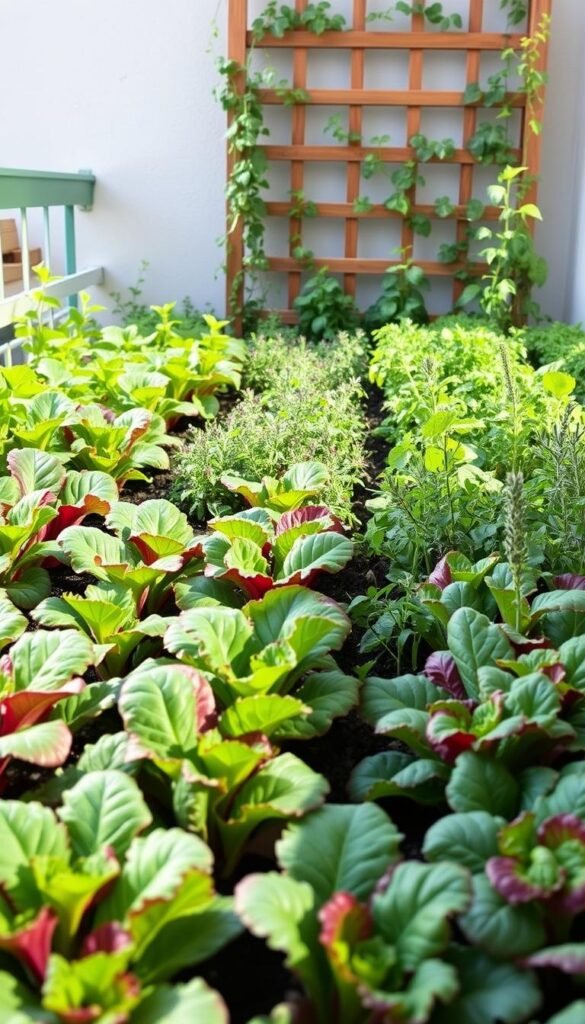
Want your pots to pump out produce like a well-oiled machine? The secret lies in timing your crops like a pro conductor leading an orchestra. Three core principles drive successful succession planting: overlapping growth cycles, smart space use, and strategic seed choices.
Sync Your Greens for Nonstop Pickings
Stagger varieties with different maturity dates. Try sowing cherry tomatoes every 14 days from spring through summer. While one batch fruits, the next develops flowers. For leafy greens like kale, harvest outer leaves regularly to encourage new growth from the center.
Pair fast and slow growers in shared containers. Spinach (30 days) thrives alongside pole beans (60 days) in deep beds. When you yank spent spinach roots, bean vines already claim the space. This intercropping trick eliminates empty dirt phases.
Boost Yields With Container Hacks
- Mark planting dates on popsicle sticks stuck in soil
- Use seedling trays to prep new crops before harvesting old ones
- Mix quick-turn radish seeds with slower carrot seeds in wide pots
Keep soil happy between rotations. After pulling bolted lettuce, work in compost tea before dropping basil starters. Consistent moisture prevents stress that triggers early flowering. Wipe containers with vinegar solution between plantings to deter diseases.
| Early Crop | Mid-Season Swap | Fall Replacement |
|---|---|---|
| Pea shoots | Bush beans | Swiss chard |
| Bok choy | Dwarf peppers | Kale |
Track each crop’s “days to harvest” like a recipe timer. Arugula bolts in heat? Sow heat-resistant varieties like ‘Astro’ after June. Your balcony becomes a precision-engineered snack factory!
Tailoring Planting Methods for Your Garden Setup
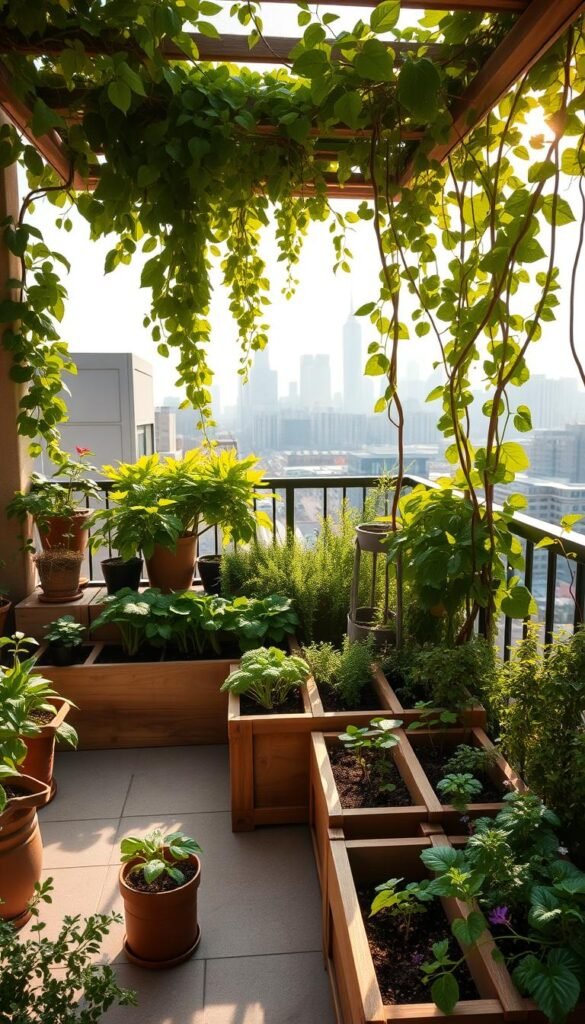
Your garden setup isn’t one-size-fits-all—discover how to make every inch work for you. Whether you’re working with raised beds, vertical planters, or window boxes, smart techniques keep harvests flowing. Let’s explore three strategies to match your space and favorite veggies.
Raised Beds and Containers
Deep-rooted crops like carrots thrive in 12″+ soil depth. Use rectangular planters for these veggies. Shallow pots? Perfect for herbs and leafy greens. Try pairing cucumbers (needing trellises) with basil below—their roots won’t compete!
Intercropping and Staggered Planting
Sow quick-growing radishes between slower carrot rows. By the time carrots need space, radishes are harvested. For cucumbers, plant new seeds every 3 weeks. This ensures a steady supply all summer.
| Setup | Ideal Crops | Companion Pair |
|---|---|---|
| Raised Beds | Carrots, Beets | Basil + Tomatoes |
| Vertical Planters | Cucumbers, Peas | Lettuce + Chives |
| Window Boxes | Spinach, Arugula | Radishes + Dill |
Adapting to Different Crop Types
Start cold-hardy peas in early spring, then switch to heat-loving beans. In fall, replace spent tomatoes with kale. Track each plant’s maturity dates—leafy greens (30 days) can cycle three times a year!
Rotate crops to prevent soil fatigue. After harvesting garlic, plant nitrogen-fixing beans. Keep taller plants north-facing so shorter ones catch sunlight. Your garden space becomes a puzzle where every piece produces food.
Scheduling Your Sowing for Nonstop Fresh Produce
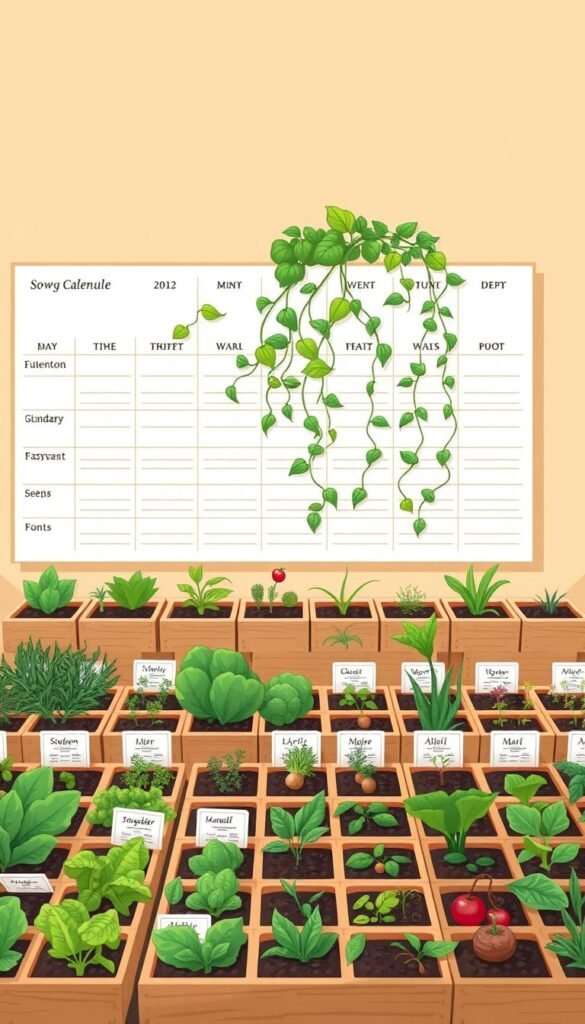
What if your containers could deliver veggies like clockwork? Crafting a smart sowing schedule turns guesswork into guaranteed results. Let’s build your personalized roadmap for year-round snacking.
Creating a Customized Sowing Calendar
Start by marking your region’s last frost date—this anchors your entire season. For tomatoes, count backward 6-8 weeks to schedule indoor seed starts. Pair quick-turn crops like arugula (21 days) with slower ones like Brussels sprouts (100 days) in shared pots.
- Use free apps to track soil temperature trends
- Note each crop’s maturity timeline on a spreadsheet
- Stagger plantings every 10-14 days for leafy greens
Example: Sow cool-weather veggies like spinach in early spring, then replace them with heat-loving okra as temperatures rise. Your journal becomes your garden’s personal assistant!
Adjusting for Weather and Seasonality
Unexpected frost? Delay sowing seeds by 7-10 days or use row covers. During heatwaves, swap bolting lettuce with heat-resistant Malabar spinach. Track these three factors weekly:
- Nighttime low temperatures
- Rainfall patterns
- Daylight duration changes
Rotate crops every 60-90 days to prevent soil fatigue. If summer tomatoes finish early, fill gaps with fast-growing bush beans. Your containers stay productive through all four seasons—no downtime!
Overcoming Common Challenges in Succession Planting
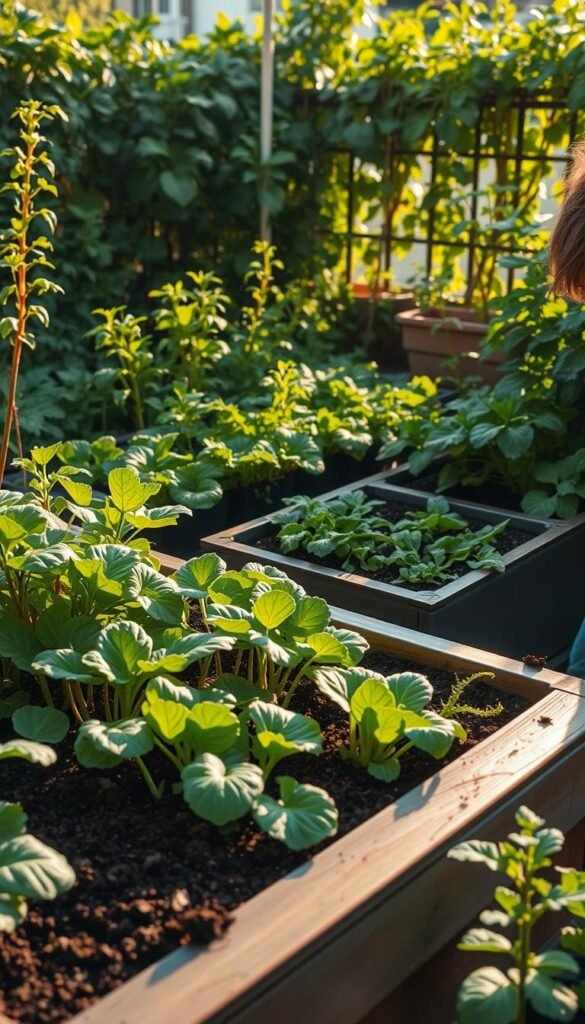
Even the best-laid garden plans hit snags—but smart growers adapt! Two hurdles often pop up: hungry pests and tired soil. Let’s tackle these head-on with simple, natural solutions that keep your edible oasis thriving.
Soil Health Made Simple
Rotate crops like a pro. After harvesting nitrogen-hungry basil, plant peas or beans next. These legumes naturally replenish the soil. For heavy feeders like radishes, mix compost into beds before sowing new seeds.
Try this 3-step gardening rhythm:
- Spring: Sow fast-growing radishes to break up compacted earth
- Summer: Follow with bush beans to add nutrients
- Fall: Plant leafy greens in the enriched space
| Problem | Solution | Crop Example |
|---|---|---|
| Low nitrogen | Plant peas | Snow peas |
| Pest buildup | Rotate crops | Radishes → Basil |
| Compacted soil | Add compost | Carrots |
Outsmarting Pests Naturally
Companion planting works wonders. Grow marigolds beside beans to repel beetles. Dill attracts ladybugs that devour aphids on your peas. For stubborn bugs, drape crops with insect netting during peak spring hatches.
Keep a journal to track what works. Note which variety of radish resists root maggots, or which bean type thrives in your space. Small tweaks create big results!
Remember: Healthy soil grows strong plants that fight pests naturally. Test your earth yearly, and amend it between planting cycles. Your succession planting efforts will yield sweeter rewards with each season.
Wrapping Up Your Bountiful Balcony Garden Journey
Your sunny nook can become a year-round snack bar with smart timing and creative layouts. By rotating crops like tomatoes and beans, you’ll enjoy crisp salads in summer and hearty greens through frost. Track sowing dates in a notebook or app—this simple habit keeps your garden humming like clockwork.
Test different varieties to discover what thrives. Try cherry tomatoes that fruit early or cold-hardy carrots for fall harvests. Pair quick-growing radishes with slower herbs to maximize every inch. Healthy soil matters: mix compost between plantings and wipe containers to prevent disease.
Remember—small spaces deliver big rewards when planned well. Start with a few pots of leafy greens in spring, then expand as confidence grows. Celebrate each handful of homegrown herbs or juicy tomato picked fresh from your urban oasis. Ready for your checklist?
Final tips: Monitor sunlight shifts monthly, stagger seeds every 10-14 days, and rotate crops to refresh soil. Your patience pays off in vibrant meals and the pride of growing food steps from your kitchen!

